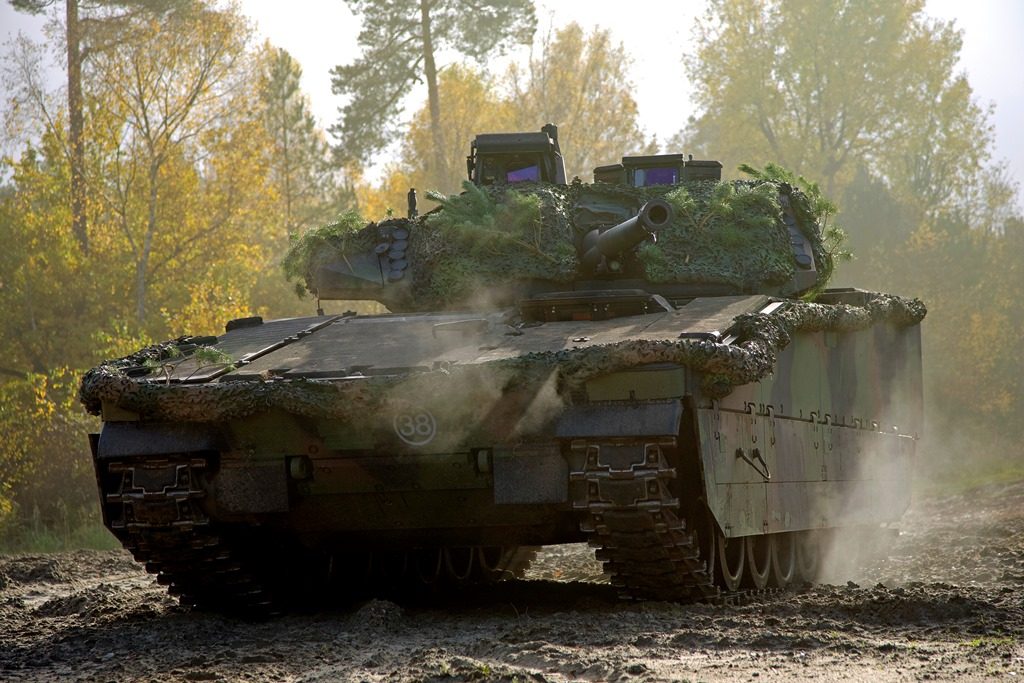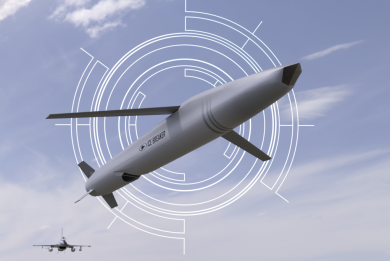
BAE Systems Hägglunds details the Royal Netherlands Army CV90 MLU
By Paolo Valpolini
On Day one at the International Armoured Vehicles Conference, organised online by Defence iQ due to the pandemic, BAE Systems Hägglunds gave a presentation that allowed to get more insight on the Mid-Life Update of the Royal Netherlands Army CV90s, which was contracted on January 13th; the briefing was presented by Gabriel Åberg, the company sales director for the Netherlands. EDR On-Line also talked to Dan Lindell, Director Combat Vehicles in Örnsköldsvik, central Sweden to get further details.
The original acquisition contract for the CV9035NL dates back to 2004, and at that time this was probably the benchmark in the Armoured Infantry Fighting Vehicles (AIFV) field, being one of the first full-digital vehicles, able to handle an automatic defence aid suite. But as the presentation title said, “Relevant – Now and in the Future”, time goes by, carrying with it technology advances that are of course exploited also by potential adversaries, so to remain on the edge the Dutch Army needs to make a full lifting of its AIFVs to ensure they will remain operationally relevant until the end of their operational life.
“BAE Systems Hägglunds carried out a pre-definition study in order to establish the needed improvements and agree on the requirements, with the aim of de-risking the MLU programme. This started in January 2020, one year before the contract signature,” Åberg explains. Four were the main bullets: situational awareness; make the vehicle compliant to the NATO General Vehicle Architecture, adding cyber-security considerations; improve protection, looking at state-of-the-art solutions which go well beyond adding tonnes of passive protection; and finally improve the firepower, and especially increasing the CV90 lethality range.


The programme was developed hand in hand with the customer, on one side the Dutch Defence Materiel Organization (DMO), for requirements issues, on the other with the Army itself, which provided the operational knowledge. Moreover operational and logistic feedbacks from the CV90 users club were also taken into the equation. “The result of that equation, agreed by all three parties, was that the best solution was to install a wholly new turret on the old chassis, reusing in the turret some of the existing capabilities that didn’t needed any type of upgrade,” Åberg adds. The system requirements were finalised in May 2020, when the definition review milestone was reached. It took then seven months to work on the contract details before reaching the signature in January 2021. Anticipating the contract by one year was due to the close cooperation between the Dutch military and the industry, and by the need to cope with ain in-service date established in early 2024.
The turret has been completely redesigned, although the structure remains based on steel, with add-on armour to reach the required level of protection, which of course remains classified. Another field on which company representatives did not elaborated is communications, as this is based on Government Furnished Equipment.
Back to the four bullets, let’s start from situational awareness. The current CV9035NL features a chassis-mounted daytime close-in situational awareness system, but lacks a 360° night observation capability. “To cope with this, a mast-mounted electro-optic head is being installed, located at the centre of the turret. It will provide all-round unimpeded vision at 10° negative elevation when the mast is raised 500 mm, allowing to avoid blind angles due to other sensors on the vehicle roof,” Åberg explains. Its identification range matches that of the new long range lethality effectors, the antitank missiles, both for the day and night channels the sensors head being also fitted with a laser rangefinder with a 10 km range and an elevation arc of –20°/+60°. The mast can be raised at whichever height, up to the 500 mm limit, the computer automatically correcting the parallax error according to the operating height. Overall the mast raises the sensors 600 mm over the turret roof level, the system being fully operational at maximum height and maximum speed, the sensors being fully stabilised. No details were provided on the type of sensor package selected by the Royal Netherlands Army, however the company representatives told EDR On-Line that all potential sensor suites include Artificial Intelligence algorithms to allow automatic target detection, reconnaissance, identification and tracking, in order to decrease the crew workload.
As anticipated, protection increase was not done by adding some tons of heavy metal or exotic materiel, but adopting an active protection system in the form of Elbit Systems’ Iron Fist LD (Light Decoupled) has been added. The decoupling of the Iron Fist components allows a greater degree of freedom to designers; on the future CV90NL turret radars will be located at the four corners of the turret, electro-optic sensors being installed on top of the mast, the whole set of sensors providing a 360° coverage. The two rotating launchers are located at the rear of the turret, these being loaded with grenade-like effectors that detonate in front of the incoming projectile neutralising it. In fact the Iron Fist did not needed to be qualified in the Netherlands, as tests had already been conducted in a previous programme. Beside their key role in the Iron Fist, the sensors also integrate into the vehicle situational awareness system.

As for firepower, the main 35 mm gun was retained without modification; guns will be removed from old turrets, they will be thoroughly checked, some components might be changed if needed, but definitely the 6,000 rounds barrel life is far from being reached by Dutch AIFV guns. In the new turret the gun has been moved forward by about 50 cm, allowing a series of improvements n various fields. First of all it freed some room inside the turret; in the new turret the commander and gunner will have no more the gun breech between them, which allowed to regroup them towards the centre of the turret providing a wider working space to both of them, that adds to the room made available by having moved the machine gun in an external pod. This allowed adding displays and other C2 related items. “Moving the gun forward also allowed us to fully redesign the ammunition feed, rounds now coming from the side, a more robust solution, which ensures a although the previous one proved pretty reliable,” Lindell explains pointing out however that “the most important effect is that this allowed us to increase by 20-25% the amount of ready rounds.” EDR On-Line understood that the Dutch vehicle might feature around a dozen more rounds compared to the current 70 available, however the final number is based on a balance between rounds and space. Another beneficial effect of moving forward the main gun is that maximum elevation will be greater than the 37° of the current turret, although no firm data were provided.
As said, the MAG58 machine gun was moved into an external pod. “Beside gaining space inside the turret, the main reason was to avoid gas inside the turret,” Lindell says, adding that the 7.62 mm weapon installed on Dutch vehicles will have 1,500 rounds available. That said, to reload it the crew will have to leave the vehicle protection, while obviously the machine gun is now less protected than in the past.
To solve the longer-range lethality issue a twin missile launcher was added, capable to host two Rafael Spike LR2 missiles. Located on the right side of the turret, with the missiles side-by-side, it is hinged at the back and rotates for some 45° allowing the launch of the missile, which in its ground version can reach a target up to 5.5 km distant. Three firing modes can be used, lock-on-before-launch fire and forget, lock-on-before-launch with redirection in flight, and lock-on-after-launch. The reload is done from the rear, with the launcher in the elevated position. The launcher is armoured, a compromise having been made between the need to ensure that the bas would vent out in case on detonation, and that to protect missiles from small arms fire. The launcher can also host Spike LR missiles, which range goes up to 4 km.

Obviously before receiving a brand new turret the chassis will be refurbished. “They will be submitted to a general overhaul,” Lindell tells us, “all subsystems will be checked and eventually replaced, while steel tracks will be replaced by new rubber tracks provided by Soucy of Canada. Even more important, both chassis and turret will be fitted with a new NGVA compliant vetronic architecture, “which will allow an easier replacement of sensors and other vetronic equipment along the years, these systems being usually those that become obsolete quicker than others due to technological breakthroughs,” Gabriel Åberg states. The new Vehicle Control System Generation 4(VCS G4) will be installed, as well as a wholly new electric system. Another key element is the adoption of a new antimine armour package, which increases the protection level, although here too data remain classified.
A considerable engineering effort was made to keep under control the weight increase; in the end, considering all the adds-on, and with a passive ballistic protection comparable to that of the old turret, but with in addition the protection provided by the Iron Fist, the new turret weighs only 400-500 kg more than its predecessor.
The prototype turret is currently under construction at Örnsköldsvik, the first of type being also planned to be build in Sweden, before moving production to the Netherlands, to the Van Halteren Defence facility. The final design review is planned for December 2023, the delivery of the first serial vehicle being scheduled for January 2024, the last of the 122 vehicles to be delivered within December 2026. Should the option for 19 further vehicles be signed, these will probably be delivered before mid-2027.
The new turret adds a new element to the already rich portfolio of options that current and potential CV90 users can draw from. The turret designed to answer the Royal Netherlands Army requirements took in count modularity, allowing easy adaptation to the needs of other services. “Beside the 35 mm cannon the turret can host the 30 mm one, but it can also be fitted with the 50 mm SuperShot,” Dan Lindell tells us. Asked about the possibility of installing a remotely controlled weapon station (RCWS), following the turret-on-turret concept, he confirms that the commander’s periscopic sight can be replaced with an RCWS, which optronics would play the role of the sight. That said, coming back to the coaxial machine gun, he adds “the weapon being in a pod, this allows for easy adaptation of a different type of weapon, such as a 12.7 mm machine gun or a 40 mm automatic grenade launcher. Should the choice go for an electrically-driven weapon, this would allow to decouple it from the main gun and to increase the elevation up to 80°.” Such a solution, plus an RCWS with a 7.62 mm MG would be pretty suitable for urban operations. The same concept applies to the missile launcher, which can easily be adapted to carry other types of missiles, such as MBDA’s MMP or Raytheon/Lockheed Martin Javelin. As for the electro-optic head mounted on the telescopic mast, the turret is system agnostic so the customer can select the system of choice.
According to Dan Lindell the new turret has raised the interest of some of the existing customers, Denmark being a potential one as it fields the BAE Systems Hägglunds AIFV armed with the same gun used by the Dutch Army. The turret will joint the newest developments, such as active damping suspensions and VCS G4, developed under the Swiss MLU contract, and the rubber tracks, which were part of the Norwegian latest requirement. “This is the beauty of having a number of international customers, each of them bringing in new enhancements that become part of the CV90 portfolio, and which are made available to all the members of the CV90 Users Club,” the BAE Systems Hägglunds Director Combat Vehicles concludes.
Images courtesy BAE Systems Hägglunds



